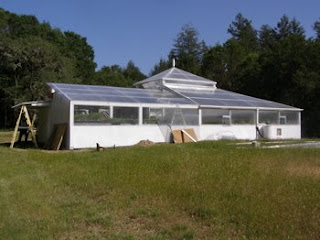
I went away for a few weeks, hence the lack of spring farming topics. Wayne, Lee and Evie are flexible in helping me step out for various personal situations...I am not tied down to a farm myself as each of them are with needs like watering, caring for animals, running a business, etc...
In my absence, plenty of seeding, growing, and planting went on as expected. Even a little more building occurred on the new greenhouse, thanks to Wayne's neighbor Montana, an entire new room was installed. The final space is designed for plants needing a cooler climate or those in the process of hardening off (preparing to head to the big outdoors and live out their days w/o the coddling environment of the greenhouse). The hardening off area is on the left in the photo above, the middle area of the greenhouse is an intermediate temperature area and on the right is the warmest place where brand new seed trays get the best spots for optimal germination.

The newly potted-up eggplant seedlings on the left are enjoying some of the best spaces in the greenhouse currently, needing plenty of warmth to get off to a happy and healthy start in life.
Baby celery plants are enjoying temperatures that range in the

60s-70s during the day in the middle room of the greenhouse, nearly ready to move out into the field for the season where they will spend months sizing up for a late summer-early fall harvest. I seeded more for the following picking yesterday in addition to the beloved celeriac/celery root. If we time this stuff just right we can hope to be sure to have these flavorful items in time for your fall harvest needs around Thanksgiving when celery suddenly becomes a component of most recipes.

A diverse mix of basil is large and ready to find it's home in the field, likely this week, perhaps even today. Plans are in the works for diverse basil bouquets again this season. If you don't see them for sale when you drop in at the farm stand, just ask, the plants will be out there ready for picking.

Finally, the first wave of chiles has been stationed in the "hardening-off" room, this means they will go outdoors soon. Chiles are dispersed throughout the greenhouse as there are so many varieties at various stages in their growth. It will be another grand season of chiles and peppers at Tierra Vegetables, no doubt.
Aside from all of this plant reporting, there is people news within the Tierra staff. A young new assistant has joined the crew who goes by the name Kara (I'm not sure if she spells it with a C or a K she is so new to me). This is the same name that Lee calls her canine companion, so it is causing some minor confusion. Kara has taken up some slack where I stepped out for a time and has become a valuable new component of the farming operation already as she assists with seeding, market sales, and everything in between.

Interested in learning more about farming and CSA, I informed her she came to the right place. Never have I gained more incidental learning at a job than the months I have spent working with this farm. The education does not stop. On the right, Kara seeds a late sowing of tomatoes and tomatillos while Lee prepares soil in the background.
One final image of the greenhouse in closing. This is a spectacular addition to the farm this season and quite an investment. It really ought to contribute to future plans and extend the capabilities of the farm in general. Note the sheep wandering past on the right and the skeleton of the old greenhouse structures behind them.


 Note the green/yellow center here that is still a good strawberry fruit and has not been damaged.
Note the green/yellow center here that is still a good strawberry fruit and has not been damaged. A frosted brown blossom hangs over one of the first of the ripe strawberries this season. There will be more, but not as many now that the night time temperatures have robbed us of some of our spring berries.
A frosted brown blossom hangs over one of the first of the ripe strawberries this season. There will be more, but not as many now that the night time temperatures have robbed us of some of our spring berries. Note the green/yellow center here that is still a good strawberry fruit and has not been damaged.
Note the green/yellow center here that is still a good strawberry fruit and has not been damaged. A frosted brown blossom hangs over one of the first of the ripe strawberries this season. There will be more, but not as many now that the night time temperatures have robbed us of some of our spring berries.
A frosted brown blossom hangs over one of the first of the ripe strawberries this season. There will be more, but not as many now that the night time temperatures have robbed us of some of our spring berries.







